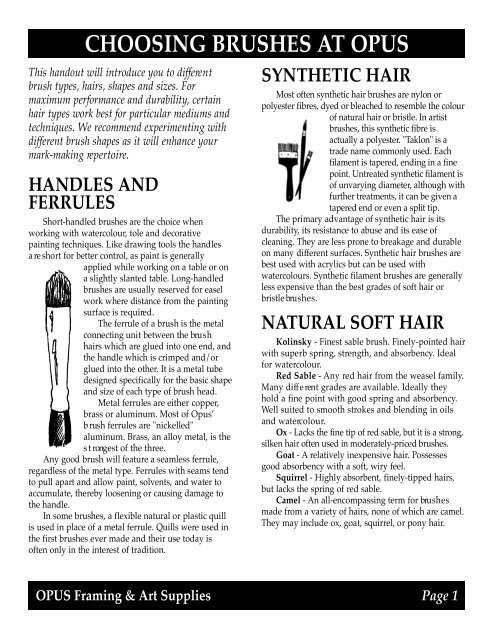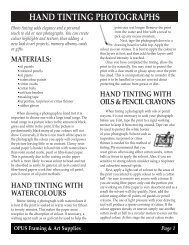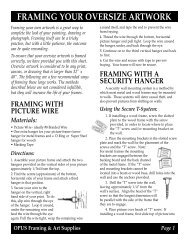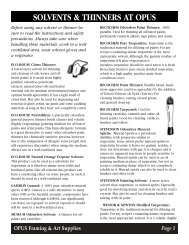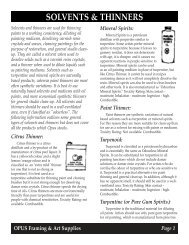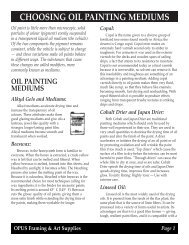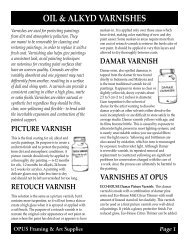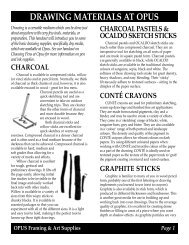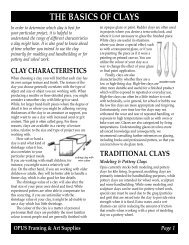CHOOSING BRUSHES AT OPUS - Opus Art Supplies
CHOOSING BRUSHES AT OPUS - Opus Art Supplies
CHOOSING BRUSHES AT OPUS - Opus Art Supplies
Create successful ePaper yourself
Turn your PDF publications into a flip-book with our unique Google optimized e-Paper software.
<strong>CHOOSING</strong> <strong>BRUSHES</strong> <strong>AT</strong> <strong>OPUS</strong><br />
This handout will introduce you to differe n t<br />
brush types, hairs, shapes and sizes. For<br />
maximum performance and durability, certain<br />
hair types work best for particular mediums and<br />
techniques. We recommend experimenting with<br />
d i f f e rent brush shapes as it will enhance your<br />
mark-making re p e r t o i re .<br />
HANDLES AND<br />
F E R R U L E S<br />
Short-handled brushes are the choice when<br />
working with waterc o l o u r, tole and decorative<br />
painting techniques. Like drawing tools the handles<br />
a re short for better control, as paint is generally<br />
applied while working on a table or on<br />
a slightly slanted table. Long-handled<br />
b rushes are usually reserved for easel<br />
work where distance from the painting<br />
surface is re q u i re d .<br />
The ferrule of a brush is the metal<br />
connecting unit between the bru s h<br />
hairs which are glued into one end, and<br />
the handle which is crimped and/or<br />
glued into the other. It is a metal tube<br />
designed specifically for the basic shape<br />
and size of each type of brush head.<br />
Metal ferrules are either copper,<br />
brass or aluminum. Most of <strong>Opus</strong>’<br />
b rush ferrules are "nickelled"<br />
aluminum. Brass, an alloy metal, is the<br />
s t rongest of the thre e .<br />
Any good brush will feature a seamless ferru l e ,<br />
re g a rdless of the metal type. Ferrules with seams tend<br />
to pull apart and allow paint, solvents, and water to<br />
accumulate, thereby loosening or causing damage to<br />
the handle.<br />
In some brushes, a flexible natural or plastic quill<br />
is used in place of a metal ferrule. Quills were used in<br />
the first brushes ever made and their use today is<br />
often only in the interest of tradition.<br />
SYNTHETIC HAIR<br />
Most often synthetic hair brushes are nylon or<br />
polyester fibres, dyed or bleached to resemble the colour<br />
of natural hair or bristle. In artist<br />
b rushes, this synthetic fibre is<br />
actually a polyester. "Taklon" is a<br />
trade name commonly used. Each<br />
filament is tapered, ending in a fine<br />
point. Untreated synthetic filament is<br />
of unvarying diameter, although with<br />
further treatments, it can be given a<br />
t a p e red end or even a split tip.<br />
The primary advantage of synthetic hair is its<br />
d u r a b i l i t y, its resistance to abuse and its ease of<br />
cleaning. They are less prone to breakage and durable<br />
on many diff e rent surfaces. Synthetic hair brushes are<br />
best used with acrylics but can be used with<br />
w a t e rcolours. Synthetic filament brushes are generally<br />
less expensive than the best grades of soft hair or<br />
bristle bru s h e s .<br />
N <strong>AT</strong> U R A L SOFT HAIR<br />
Kolinsky - Finest sable brush. Finely-pointed hair<br />
with superb spring, strength, and absorbency. Ideal<br />
for waterc o l o u r.<br />
Red Sable - Any red hair from the weasel family.<br />
Many diff e rent grades are available. Ideally they<br />
hold a fine point with good spring and absorbency.<br />
Well suited to smooth strokes and blending in oils<br />
and waterc o l o u r.<br />
O x - Lacks the fine tip of red sable, but it is a stro n g ,<br />
silken hair often used in moderately-priced bru s h e s .<br />
G o a t - A relatively inexpensive hair. Possesses<br />
good absorbency with a soft, wiry feel.<br />
Squirrel - Highly absorbent, finely-tipped hairs,<br />
but lacks the spring of red sable.<br />
Camel - An all-encompassing term for bru s h e s<br />
made from a variety of hairs, none of which are camel.<br />
They may include ox, goat, squirrel, or pony hair.<br />
<strong>OPUS</strong> Framing & <strong>Art</strong> <strong>Supplies</strong> Page 1
B R I S T L E<br />
Bristle, as its name implies, is a stiff hair derived<br />
from a hog, pig, or boar. It is a coarse, strong hair that<br />
ideally has a natural curve and flagged tips. This "flag",<br />
or split tip, helps the brush to hold maximum paint<br />
and acts as an extra "paintbrush" during application.<br />
Bristle is well suited to work with heavier media such<br />
as oils, acrylics, and tempera. White bristle comes in<br />
many grades. Black bristle is a stiffer, more<br />
economically-priced hair.<br />
SIZES OF <strong>BRUSHES</strong><br />
Numbering brushes in "sizes" provides order for<br />
d i ff e rentiating brushes within a series. The size is<br />
determined by the measurement of the ferru l e<br />
opening. Rounds are measured as if the<br />
f e r rule and hair have been flattened.<br />
In Canada, the imperial or metric system<br />
of sizing is commonly used, depending upon<br />
the type of brush. Natural bristle brushes are<br />
m e a s u red using the imperial system, which<br />
means a size 12 is equal to one inch. In turn, a<br />
size 6 is 1/2 inch, a size 18 is 1-1/2 inches,<br />
and so on.<br />
Natural soft hair and synthetic brushes are<br />
measured using the metric system. One<br />
millimetre is equal to a size 1. This standard is<br />
effective, except that it is difficult to measure<br />
and assign a value to any measurement less<br />
than 1 mm. So, when a brush is sized 10/0, 3/0, etc. it<br />
becomes quite hypothetical. Roughly translated, 3/0<br />
means 3 units (undefined) less than a millimetre and<br />
10/0 means 10 units (undefined) less than a millimetre.<br />
Please note that there is no industry standard<br />
that manufacturers must follow. Sizing for various<br />
types of brushes is often rooted in tradition and the<br />
country of origin.<br />
BRUSH CARE<br />
<strong>CHOOSING</strong> <strong>BRUSHES</strong> <strong>AT</strong> <strong>OPUS</strong><br />
1. When cleaning a brush made from natural hair,<br />
use cool water. Hot water will strip the natural oils<br />
f rom the hair.<br />
2. Always rinse the brush thoroughly in the<br />
a p p ropriate solvent (water or paint thinner) to re m o v e<br />
as much of the remaining colour as possible.<br />
3. Gently massage the brush in the palm of your hand<br />
using a small amount of gentle soap or brush cleaner*.<br />
4. Repeat steps 1-3 until the brush comes clean.<br />
5. Rinse the brush thoroughly and allow to dry<br />
upright or hanging downward .<br />
6. If natural hair brushes are not going to be used<br />
for a long period of time in a humid climate, it is wise<br />
to store them in an enclosed container with a mothball<br />
or two.<br />
7. Synthetic brushes that have become misshapen<br />
can sometimes be brought back to ‘life’ and into a<br />
useable profile by placing them under hot (not<br />
boiling) water. This will soften the synthetic hair.<br />
8. If natural hair brushes become misshapen, using<br />
a bit of soap on your fingers to bring the wet hairs to a<br />
point will enable the brush to hold a point when store d .<br />
9. Keeping the brush clean will dramatically<br />
extend the life of the bru s h .<br />
* <strong>Opus</strong> carries “The Masters” Brush Cleaner and<br />
P reserver which can be used for cleaning oils, acrylics<br />
and watercolours from your brushes. For hard to clean<br />
paints such as oil “The Masters” Brush Cleaner can be<br />
left on brushes for a short period of time until the<br />
b rushes set. This process can be repeated until the<br />
b rushes come clean.<br />
BRUSH STORAGE<br />
T h e re are a number of solutions for storing or<br />
carrying your brushes when not in use. The simplest<br />
and most economical is to store them upright in a tin<br />
can or jar.<br />
T h e re are also bamboo brush wraps, canvas bru s h<br />
carriers, wooden brush boxes, and plastic brush tubes<br />
available. When choosing a brush carrier, ensure that<br />
air and moisture are able to pass freely through the<br />
material or through holes provided. It is important<br />
that moisture is not trapped in your brush carrier to<br />
p rolong the life of your brush hairs and to pre v e n t<br />
c o r rosion of the ferru l e s .<br />
<strong>OPUS</strong> Framing & <strong>Art</strong> <strong>Supplies</strong> Page 2
<strong>CHOOSING</strong> <strong>BRUSHES</strong> <strong>AT</strong> <strong>OPUS</strong><br />
BRUSH SHAPES & USES<br />
The names for same or similar shapes, in various hairs<br />
or handle lengths, appear in parentheses.<br />
Round - Use on point, or apply pressure to make thickto-thin<br />
strokes.<br />
Liner - Continuous curved or straight lines. Thickness<br />
varies with pressure changes.<br />
Ultra Round - Use as a liner on point. Full belly<br />
provides a reservoir for paint and water.<br />
Script-Liner (Long Liner) - S c roll work, flowing thickto-thin<br />
lines. Length of hair holds more paint than a<br />
regular liner.<br />
Flat (Shader) - Blocking in colour, shading, blending,<br />
highlighting, and stroke work.<br />
Bright (Chisel Blender) - Short, flat strokes and<br />
blending, especially useful with heavy mediums.<br />
Angular Shader (Angle Flat) - Tight shading, curved<br />
strokes. Popular rose petal brush.<br />
Wash (or Glaze) - Washes, bases and applying finishes.<br />
One Stroke (Stroke) - Long, flat lettering brush.<br />
Filbert (Oval) - Strokes with soft edges. Blending. A<br />
natural flower petal shape.<br />
Deerfoot Stippler - Texturing brush. Use for dry brush<br />
techniques or with a light, pouncing movement for fur,<br />
shrubbery, and soft backgrounds.<br />
Fan - Use dry or with tips loaded to create texture or<br />
smooth other brush strokes.<br />
Rake - Flat, texturing brush with a naturally-fingered<br />
shape. Use for hair, grass, wood grain, feathers, and fur.<br />
Dagger Striper - Long chisel edge for easy, fine lines.<br />
Vary pressure for thick-to-thin ribbon effect.<br />
Miracle Wedge - Can be easily loaded with 3 different<br />
colours for a variety of stroke effects.<br />
Stencil - Use with dry brush techniques with very little<br />
paint and with a circular or stippling motion.<br />
Mop - Blending and softening. Washes.<br />
Varnish Brushes (not pictured here)- A wide flat bristle<br />
b rush for covering large areas. For applying varnish to oil<br />
paintings a badger hair brush is ideal. For applying varnish to<br />
an acrylic painting any wide soft synthetic brush will work.<br />
<strong>OPUS</strong> Framing & <strong>Art</strong> <strong>Supplies</strong> Page 3
N O T E S :<br />
<strong>CHOOSING</strong> <strong>BRUSHES</strong> <strong>AT</strong> <strong>OPUS</strong><br />
O P U S<br />
F raming &<br />
A r t <strong>Supplies</strong><br />
‘where artists prefer to shop’<br />
<strong>OPUS</strong> Vancouver <strong>OPUS</strong> Langley <strong>OPUS</strong> Victoria<br />
1360 Johnston St 5501 204 St 512 Herald St<br />
604-736-7028 604-533-0601 250-386-8133<br />
<strong>OPUS</strong> Kelowna <strong>OPUS</strong> North Vancouver <strong>OPUS</strong> National<br />
1357 Ellis St 120 Lonsdale Ave Mail Order Service<br />
250-763-3616 604-904-0447 1-800-663-6953<br />
www.opusframing.com<br />
<strong>OPUS</strong> Framing & <strong>Art</strong> <strong>Supplies</strong> Page 4


